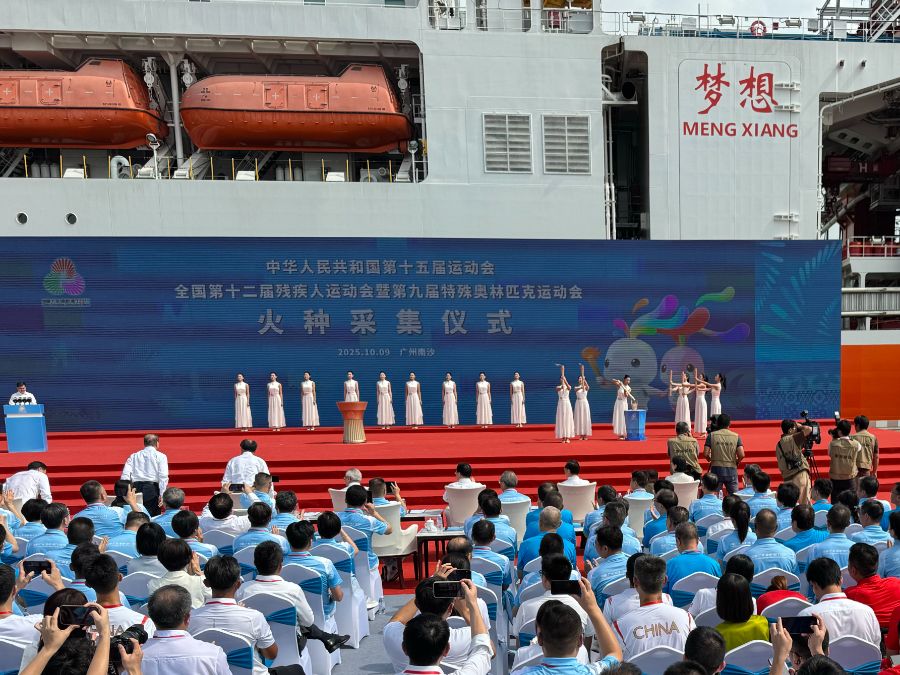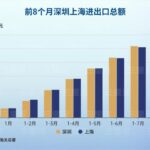On October 9th, witnessed by the “Dream” ocean drilling vessel, the flame collection ceremony for the 15th National Games and the 12th National Games for Persons with Disabilities & 9th Special Olympics (referred to as the “15th National Games and Special Olympics”) was held at the scientific research dock of the Guangzhou Marine Geological Survey Bureau in Nansha District, Guangzhou.
On the same day, the official song of the 15th National Games, “Momentum Like a Rainbow,” was released, marking the 30-day countdown to the opening of the 15th National Games and Special Olympics. This grand event, integrating technology and sports, reflects China’s determined strides toward maritime strength and the broad prospects for coordinated development in the Guangdong-Hong Kong-Macao Greater Bay Area.
Guangdong, Hong Kong and Macao Jointly Light the National Games Flame
At the flame collection ceremony, representatives of the flame collection technical team walked onto the stage holding the “source fire” box and solemnly presented it to the principal responsible comrade of the Guangzhou Municipal Committee. The principal responsible comrade of the Guangzhou Municipal Committee raised the “source fire” box high with both hands, displaying this precious “source fire” collected from the depths of the South China Sea to the entire audience.
The flame guard team placed the “source fire” box on the “source fire” platform, beginning the lighting of the flame cauldron. The flame collection maidens ignited their collection torches from the “source fire” platform. The principal responsible comrades from the General Administration of Sport of China, the China Disabled Persons’ Federation, and the Guangdong Provincial Party Committee and Government, together with the Chief Executives of the Hong Kong and Macao Special Administrative Regions, ascended the stage and received the collection torches. Amidst the gaze of the entire audience, they raised their collection torches high and jointly lit the flame cauldron for the 15th National Games and Special Olympics, symbolizing the joint progress and shared dreams of Guangdong, Hong Kong, and Macao.
At the scene, the National Games flame was transferred into four flame lanterns. Representatives from the Executive Committee for the Guangdong Competition Area of the 15th National Games, the Executive Committee for the Guangdong Competition Area of the Special Olympics, the Preparatory Committee for the Hong Kong Competition Area, and the Organizing Committee for the Macao Competition Area respectively received the flame.
It is reported that after the completion of the flame collection for the 15th National Games and Special Olympics, the flame will travel to four cities: Hong Kong, Macao, Guangzhou, and Shenzhen, with torch relays scheduled to be held in these four cities in November.
“Source Fire” from 1,522 Meters Deep in the South China Sea
Previous National Games flame collections have collectively showcased the host region’s socio-economic achievements, profound cultural heritage, and the uplifting spirit of its people.
The Guangdong-Hong Kong-Macao Greater Bay Area is located on the coast of China’s South China Sea, possessing abundant marine resources. The “source fire” for the 15th National Games and Special Olympics comes from 1,522 meters deep in the South China Sea, demonstrating the striving spirit of sports, the courage to explore in science, and the concept of sustainable development.
It is understood that this flame collection activity included two major segments: “source fire” collection and “sacred flame” lighting. At the event site, the “source fire” collected from the deep sea was unveiled for the first time.

On November 17th last year, at the scientific research dock of the Guangzhou Marine Geological Survey Bureau, China’s first independently designed and built ocean drilling vessel, the “Dream,” was officially commissioned, making China the third country in the world capable of independently designing and building ocean drilling vessels. In September this year, following the footsteps of the “Maritime Silk Road,” the “Marine Geology No. 2,” serving as the support vessel for the “Dream” ocean drilling vessel, set sail for the South China Sea with the honorable mission of collecting the “





